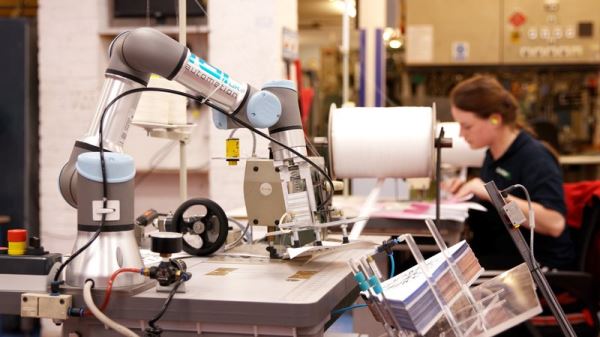Many workers still view advanced automation as a threat to their employment.
But nothing could be further from the truth, says James McKew, Regional Director for Asia-Pacific at Universal Robots.
“The proof lies in the name,” he says.
Collaborative robots, fondly known as cobots, work safely alongside humans and as the name suggests, it is all about collaboration.
“Cobots are not a threat to human labour, they help to enhance the quality of production and the ability for humans and robots to collaborate.”
According to McKew, the fear of robots taking over is natural.
Universal Robots, however, was founded on “empowering people” and shifting from “people working like robots” to “people working with robots.”
When some think of robots, they cast their minds back to those seen in the movies.
However, in manufacturing their main purpose is assist people with the dull, dusty, monotonous and non-creative aspects of production processes, says McKew.
Cobots should not be confused with industrial robots, he says.
“Cobots are designed to be human-friendly – they have systems on-board that can detect humans and they do not need to be caged.
“Cobots will not hurt humans whereas industrial robots may. They are easy to use, easy to program and lightweight. In fact, even operators with limited programming skills can become cobot programmers.”
‘Business as usual’
Now, in a time of ongoing lockdowns, border closures and heightened concerns around health and safety, cobots allow for “business as usual” – even in the most unprecedented times, McKew says.
Adding to this is the reliance on a global supply chain by local manufacturers who are changing their production over to bring manufacturing home and ensure business continuity.
“Cobots act as a lifeline for local businesses that need to accelerate local manufacturing. Cobots ensure enhanced productivity, reduced errors and improved efficiencies.”
With cobots, production workers can start to master robotics.
And they can take over the dull, monotonous jobs that talented and dexterous humans should not be doing.
With an aging population in the manufacturing sector and fewer young people wanting to do manual factory tasks, cobots are helping to transform this environment, making it more attractive younger workers.
“They now have the ability to program and manage cobots which makes manufacturing a desirable career choice for the future,” says McKew.
What the future holds
McKew sees robot cell operators enhancing processes and adding value to human-machine
operators.
Many machines can be tended by several cobots while a person is left in charge of managing all of them.
“They program them, optimise them, and determine if there are more creative ways that the cobots can be used to enhance production output.”
According to McKew, Universal Robots is on a journey to “shift humans who are working like robots to humans mastering robots themselves.”
The opportunities are immense for countries to resume production. The pandemic has taught countries that strategically sourcing away all production is not actually very strategic.
“Cobots along with talented manufacturing workers provide companies with massive opportunities for efficient reshoring in the post-pandemic world.”
APAC cobot expo
Next Tuesday and Wednesday, Universal Robots will again host the largest virtual collaborative robot (cobot) exhibition in the Asia Pacific (APAC) region – Collaborate APAC – Cobot Expo.
This year’s theme is entitled ‘Collaborate’ and will feature some of the company’s prominent global spokespersons as part of an informative panel discussion.
Register for the live event:
https://www.universal-robots.com/sg/collaborate-apac-cobot-expo-2021/


